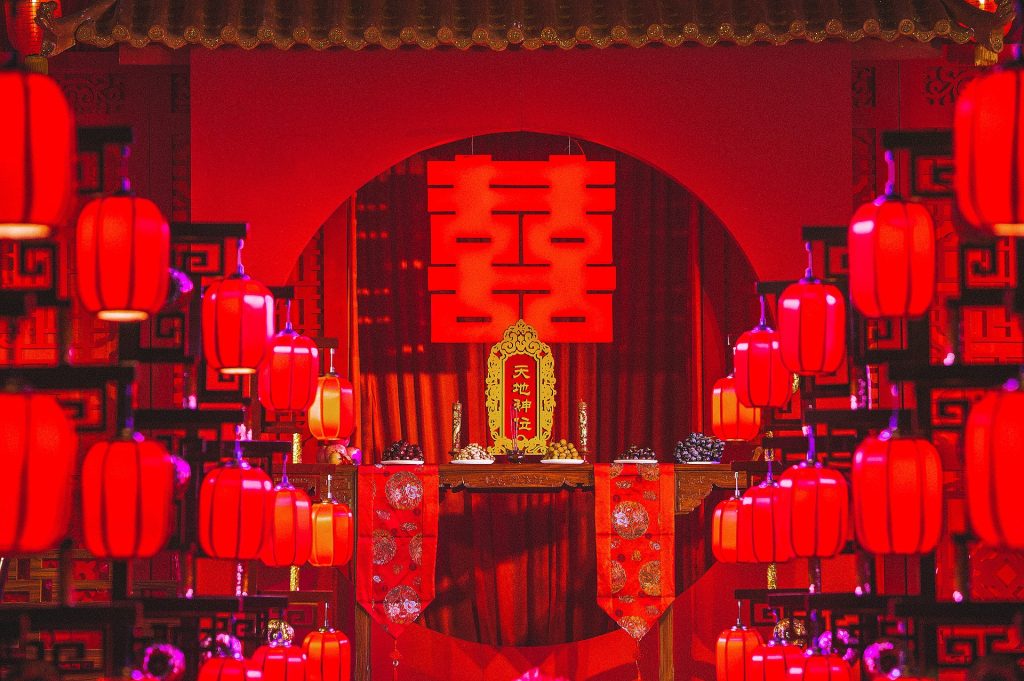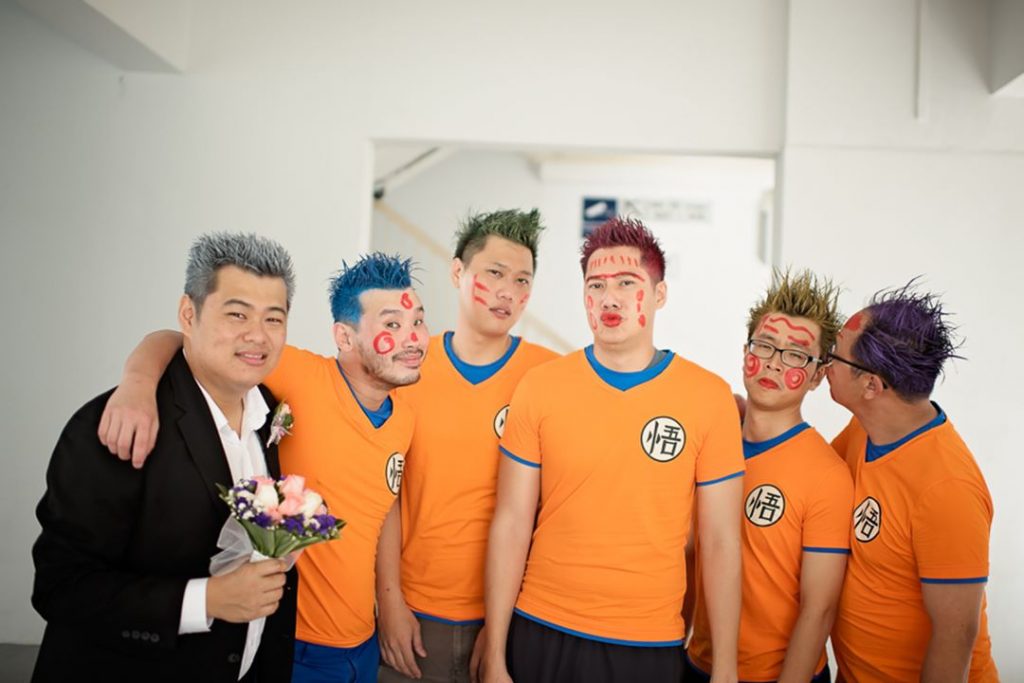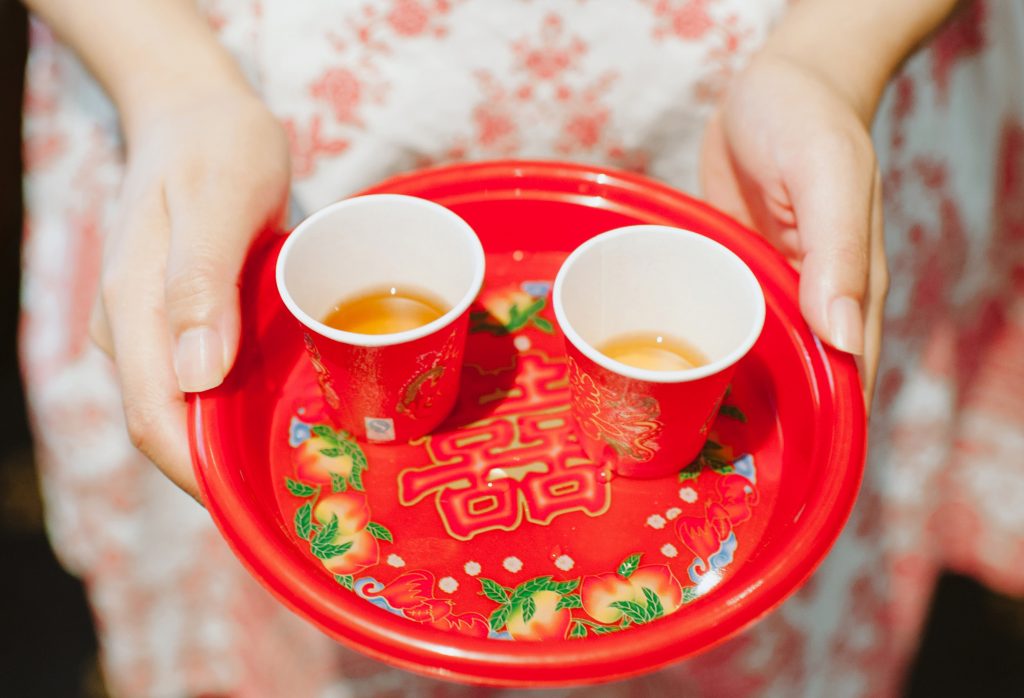Diapers, chilli padi, live worms—nothing is taboo in this world that exists outside the Geneva Conventions.
Known locally, and colloquially, as gatecrashing, it is a “traditional Chinese ceremony … to test the groom’s resolve and determination to get his wife,” as Her World describes.
My friend Lynette, who wedded her beau last December, has a different interpretation of the practice: “it’s cause last time the couples only met on their wedding day, and it was awkward, so people played games.”
Jerry, 30, picks up this thread of playing games as an icebreaker, but wonders if gatecrashing is designed more “to encourage secondary pairings between groomsmen and bridesmaids … the whole thing has a very JC-orientation-mating-ritual feel to it”.
Regardless of how each person understands its symbolism, gatecrashing has seeped so deeply into Singapore’s cultural consciousness that it is seen as a venerable Chinese tradition with roots reaching hundreds of years back.
Except that it is none of these things. I think.

As the priest arrives, Teck puts on his hat, which has a red thread wound around it. The ceremony begins. The priest starts off chanting a litany of holy names, during which Teck has his hair combed ceremonially to symbolise his coming of age. Next, the priest sprinkles water from a vegetable around Teck, now prostrate on the ground. Last, he stamps Teck’s garments with a seal of good luck, signalling the end of the ritual.
Teck can now receive his bride. He brings along a flowing red banner calligraphed with the names of the happy couple, baskets of cake, and a marriage certificate. At his bride’s house, he presents the bridal gifts, along with some ang pows, to the bride’s family and friends. He then pays his respect at the bride’s family altar. Finally, he is allowed entry into the chamber, and sees his bride for the first time.

I’m not suggesting all marriages that took place in 20th-century Singapore conformed to this template, but it is representative of the ceremonies that led up to the groom fetching the bride at her house. If you had attended a Singapore Chinese wedding anytime before the 2000s, you would probably more likely see, at the bride’s house, an exchange of symbolic items to ensure matrimonial bliss rather than groomsmen prancing around in diapers.
In other words, contrary to popular belief, gatecrashing is hardly a time-honoured Chinese wedding tradition.
Mdm Tay (otherwise known as “my mother”) corroborates this assertion, scoffing: “When I got married [in the early 1980s], where got play game one? Young people like to come up with new pattern and just follow.”
Indeed, until 2016, our newspapers did not use the word “gatecrashing” in the sense that we understand today (“horrific games set upon unsuspecting participants”), but in its traditional definition of “enter[ing] (a party or other gathering) without an invitation or ticket”.
“Robbers gatecrash two New Year Parties”, screams a 1966 The Straits Times headline; “A family of four gatecrashed a wedding dinner in a Jurong restaurant recently and stuffed themselves at the expense of the happy couple,” The New Paper reports in 1995.
Clearly, gatecrashing, as a term denoting part of the wedding ceremony, wasn’t even recognised in our popular lexicon just 20 years back.
How, then, did gatecrashing attain its hallowed position in Singapore Chinese culture today?

Romance, Hopes and Dreams, a National Heritage Board of Singapore (NHB) exhibition on marriage, claims that gatecrashing is one of the “modern practices derived from the West”.
The West? Joo Koon ah? I don’t know, because the exhibition isn’t running now. Sorry.
Dr Tan Ern Ser, Associate Professor in sociology at the National University of Singapore, explains to The New Paper in a 2016 article: “The games were created by English-educated, middle-class young people in Singapore.”
“I suppose,” he goes on, “the original intent is to make the groom demonstrate his love and sincerity towards his bride through having to cross a difficult barrier of ‘sisters’ with their often ridiculous [and humiliating] requirements.”
Today, “it has become a sort of power play between the sexes,” Dr Tan elaborates, with, I imagine, a gravity that only someone scarred by the experience of bridal torment can muster.
However, when I reached out to Dr Tan, he was unable to provide me with additional sources that echoed his claim about the English-educated and middle-class origins of gatecrashing. Neither could I find any material that backed this line of argument.
In Cantonese custom, when a groom wants to fetch his bride, he first has to “bribe” his way through a throng of people resisting his advance like panicky governments closing their borders to Chinese nationals.
Leong Huan Chie, author of the Master’s thesis Understanding Marriage: Chinese Weddings in Singapore, theorises that modern gatecrashing games might have evolved from this tradition. (Emphasis on “theorises”.)
Along similar lines, some users on various Reddit threads think that gatecrashing was the product of imitating a popular TVB drama serial which itself presumably drew inspiration from traditional Cantonese wedding customs.
Unfortunately, I have no way of verifying either scenario because the only Cantonese words I recognise are “leng zai” (me) or “hum sup” (also me).
When Zhu Jieren, director of Shanghai’s East China Normal University Press, got married, he decided to do away with “customary ‘tests’ of the groom’s courage and persistence, such as contending with the bride’s neighbours and friends who blocked access to her home”.
However, this sparked a backlash among some kaypoh Chinese, who commented that Zhu was not honouring ancient traditions. In response, Zhu pointed out that there was a difference between “folk customs” and “true Confucian ritual[s]”.
This account of gatecrashing thus suggests that, in China, gatecrashing has roots in rural “folk customs” and is in fact not an offshoot of any “established” religion or practice, such as Confucianism or Cantonese customs.
(The above information is cited from the article “Modernizing Tradition or Restoring Antiquity as Confucian Alternatives: A View from Reading Wedding Rituals in Contemporary China”. It was written by Margaret Mih Tillman and Hoyt Cleveland Tillman, who are both history professors.)

Three of the four theories argue that gatecrashing is a relatively modern phenomenon, either inspired by a Cantonese custom, invented by raunchy English-educated, middle-class Singaporeans, or influenced by the anarchic, immoral West; the last theory lends credence to the belief today that gatecrashing has a long history rooted in tradition, though in folklore rather than any form of organised religion or practice.
Short answer: I don’t know.
While I can make no conclusion on the origins of gatecrashing in Singapore, after my research, it is now clear to me that gatecrashing is more a local and modern phenomenon than the ancient Chinese tradition we tend to think it is.
In fact, it took me a great deal of time trawling through books, newspaper articles, Reddit, and emailing professors, wedding photographers, and planners, before I even managed to find a hypothesis of how gatecrashing in Singapore came about.
Unfortunately, the more research I conducted, the more conflicting my evidence became—a fact made worse by the lack of substantiation their respective authors provided.
I share my research woes not to wayang or elicit sympathy. Rather, I want to point out that the historical lacuna behind gatecrashing has not prevented it from being cemented, and viewed, as a wedding tradition—which made me wonder how many other practices that we revere as traditional values or even immutable morals started off as a whim.
Monogamy? Employment? Having three fixed meals a day? The concepts of money or time? Whatever is under the umbrella of “Asian values”?

Rituals, customs, traditions all serve a function in society. As much as my friends and I, like most millennials, grumble about reunion dinners during Chinese New Year, the reality is most of us enjoy it and would continue the tradition when we age into creaky old people.
“Rites”, as the sociologist Émile Durkheim writes, “are ways of acting that are born only in the midst of assembled groups and whose purpose is to evoke, maintain, or recreate certain mental states of those groups.”
And, as any politician knows, when mental states are controlled and synchronised, societal unity follows. In other words, rites, rituals, customs—whatever synonym you can come up with—are integral to the smooth functioning and even happiness of society. This is Durkheim again:
“Everything changes when a [rite] takes place … Once the individuals are gathered together, a sort of electricity is generated from their closeness and quickly launches them into an extraordinary height of exaltation.”
But, after discovering how culturally hollow the practice of gatecrashing is, I realised that continuance of a rite or ritual should not rest on the fact that people have practised it so many times that it becomes almost like an unconscious reflex. Nor should historicity lend legitimacy to the continued observance of a tradition.
The only criteria for whether we choose to extend the lifespan of a ritual or adhere to prescriptive dogma, then, is if we can find meaning—whatever our understanding of “meaning” is—in it, and not blind observance to flimsy concepts like “tradition” and “historical practice”.






